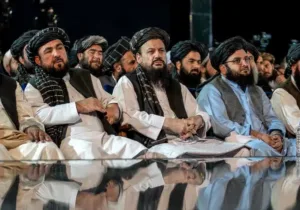As the war for Afghanistan winds down, the battle to write its history is beginning. Carter Malkesian argues that the United States failed in Afghanistan because of “intractable grievances, Pakistan’s meddling, and an intense Afghan commitment to resisting occupiers.” Much of his narrative is spot-on, including that the Bush administration invested too little in rebuilding the Afghan army and that the US government never figured out how to respond to Pakistan’s duplicity.
But Malkesian gets several key events wrong. He blames President George W. Bush for not including the Taliban in the new Afghan government in 2001, and he judges President Barack Obama’s surge of troops from 2009 to 2012 a mistake—yet also believes Obama’s withdrawal timetable did not hurt the war effort. Malkesian suggests that the lesson of the Afghan war is that the United States should be more open to diplomacy and less reliant on military force. In fact, the war should teach us that hard and soft power work best when used together—a conclusion that should sound familiar to Christian realists for whom the world is never so free of sin that soft power alone is sufficient, yet never so forlorn of hope that only hard power is effective.
The Bush Record
The Bush administration did not have a consistent, blanket policy of excluding the Taliban from the new Afghan government. To begin with, the Taliban excluded themselves. When Bush addressed the US Congress on September 20, 2001, he gave the Taliban a choice to cooperate against al-Qaida, hand over senior leaders, close training camps, and release American prisoners; in short, “hand over the terrorists or…share in their fate.” According to Bob Woodward’s account in Bush at War, Washington reached out to the Taliban through Pakistani intermediaries in the immediate aftermath of the 2001 terrorist attacks, to no avail. The Taliban’s absence from the Bonn Conference in December 2001 was not because they asked for and were refused admission, but because they were still fighting US and Northern Alliance forces on the field of battle, having chosen to throw in their lot with al-Qaida.
In the years since, persistent reports have circulated that selected senior Taliban leaders attempted to surrender to US or Coalition forces, that the US rebuffed them, and that if the US had accepted their surrender it might have prevented the Taliban insurgency from breaking out in late 2005. Malkesian accuses the Bush administration of “pushing the Taliban back to war,” by refusing to talk with the Taliban. (And there is hearsay, but no documented evidence, that some Taliban did request admittance to Bonn.)
In fact, the US did accept senior Taliban surrenders, including Taliban Foreign Minister Wakil Muttawakil in early 2002. Muttawakil, along with several other former senior Taliban leaders, later ran for a seat in the new Afghan parliament and was disowned by the Taliban for his moderation. Another former Taliban deputy minister was twice appointed to a seat in the Afghan Senate before the Taliban assassinated him in 2012. With American support, Afghan President Hamid Karzai inaugurated a reconciliation program for former Taliban fighters early in his administration, and the Afghan parliament passed a blanket amnesty in early 2006 for anyone willing to lay down arms and foreswear violence.
None of these moves prevented the insurgency, the enabling conditions for which included the Taliban’s safe haven in Pakistan, money from the drug trade, and a power vacuum in the provinces. Most importantly, the Taliban simply persisted in its ideological hostility to the new Afghan government, illustrated by their assassination campaign against a long list of clerics who supported the new regime. The problem, then, was not a lack of diplomacy by the United States, but a lack of security in Afghanistan.
The Bush administration’s sporadic interest in talking with the Taliban suffered, like all its policies in Afghanistan, from the war in Iraq. Greater attention and focus, coupled with more military resources to train the Afghan army and police (as Malkesian rightly highlights) and provide security in the provinces might have improved security earlier and faster and thus given more impetus to diplomatic efforts. The lesson is not that the US should adopt a universal policy of conciliation toward future enemies, but that when faced with an intractable conflict it should leverage both its military and diplomatic tools together.
Obama’s Surge and Withdrawal
Malkesian’s reading of the Obama administration’s record is even more strained, as are the lessons he draws from it. He rightly notes that Obama’s surge was militarily successful, yet still judges it to have been a mistake. “The surge stabilized the most important cities and districts, vitalized the Afghan army and police, and rallied support for the government,” he writes. It is odd that he subsequently claims that had Obama forgone the surge, “U.S. casualties and expenses would likely have been far lower and still the conditions would have changed little.”
But conditions were not unchanged by the surge. By Malkesian’s own assessment, the surge gave the Afghans and their international allies the initiative, domestic support, greater stability, and higher morale. More importantly, the surge created the conditions for the first serious negotiations between the United States and the Taliban. Talks between the two sides were held in Qatar for the first time in 2011, at the height of the surge, almost certainly because the Taliban felt the military pressure. Military progress yields bargaining leverage, and Obama was on the cusp of a diplomatic breakthrough because of the surge.
Obama failed, of course, because he undercut his leverage by announcing his intent to withdraw US forces. Malkesian falsely claims, “There is scant evidence to support the charge that if Obama had given no timeline, the Taliban would have been more exhausted by the surge and would have given up or negotiated a settlement.” In fact, there is plenty of evidence. Most obviously, critics at the time warned that the Taliban would take the withdrawal announcement as assurance that they could simply wait the United States out (the US even reportedly intercepted communications of the Taliban saying so), which is exactly what they have done.
Peace talks petered out after 2013 because the US withdrawal was underway. From a peak of 100,000 US troops in Afghanistan during the surge, there were 65,000 US troops at the start of 2013, 40,000 in 2014, and just 9,800 in 2015. The Taliban had no reason to talk because the US was conceding their main demand—the unilateral withdrawal of US forces—without demanding concessions in return.
In my research about withdrawal timetables in Vietnam, Iraq, and Afghanistan, I found that withdrawal announcements, timetables, and deadlines generally do not secure the advantages that presidents hope for, but do incur the risks they fear, including the loss of military advantage and diplomatic leverage. That scenario played out in Afghanistan in plain sight for everyone, including the Taliban, to see. The lesson of the Obama years is that military pressure can augment diplomatic leverage, but it requires time to take effect.
Taliban Myth-Making
Aside from his characterization of Bush’s and Obama’s strategies, another problem with Malkesian’s narrative is how closely it tracks with the Taliban’s version of events. He judges the Taliban insurgency to have been so persistent and successful because, he says, it can draw on Afghans’ legendary resistance to occupation, giving them stronger morale, staying power, and the will to fight. The lesson for Malkesian, apparently, is that the United States is militarily powerless against the united will of the Afghan people.
There are several problems with this. First, there is no unique Afghan trait of resistance to invaders. Europeans who fought Nazi occupation and Asians who suffered under Imperial Japan would be surprised to find that resistance to invasion belongs uniquely to the Afghans. The notion that Afghanistan is a fabled “graveyard of empires” is an Orientalist myth that was invented in 2001 by Western scholars eager to have something to say about a country no one had studied in a decade. We do not need to resort to Malkesian’s explanation that “the Taliban exemplified an idea—an idea that runs deep in Afghan culture,” of resistance to outsiders. The Afghans were hardly the only subject people to rise up against British or Russian imperial rule.
More to the point, Afghans today do not see the war as a war of resistance to outside invasion. According to the Asia Foundation’s annual Survey of the Afghan People, Afghans do not sympathize with the Taliban. Just four percent of Afghans said they had “a lot of sympathy” for the Taliban in 2019, an all-time low, while 85 percent have no sympathy at all. Support for the Taliban has dropped every year since 2009, suggesting that Afghans almost certainly do not view international forces as occupiers, undermining Malkesian’s claim that the American presence “inspired Afghans to defend their honor, their religion, and their homeland.” The Taliban is widely unpopular in the country they claim to be liberating, which is why their insurgency has generally failed to gain widespread backing despite the persistent corruption and weakness of the Afghan government and the incompetence of their international supporters.
Similarly, there is not, and never has been, an “occupation,” a simple fact most Afghans understand. The Taliban naturally refers to international military forces as occupiers, but Malkesian himself refers to “the U.S. occupation,” and “the occupation” of Afghanistan apparently in his own voice. But unlike Iraq, Afghanistan was never under military occupation by the United States or by the UN-authorized International Security Assistance Force (ISAF). US and international forces have always operated under UN authorization and at the invitation of the Afghan government. To characterize the international military presence as an occupation is to act as a volunteer recruit for Taliban propaganda.
A better way to make the point that I think Malkesian is trying to convey is that the Taliban is better at propaganda and information warfare than the United States and the Afghan government. Washington and Kabul have a message to sell—a message about peace, freedom from foreign (Pakistani) invaders, rejection of terrorism, and national unity—but have proven incompetent messengers. The United States is not powerless against the Taliban, nor are the Afghan people. Public diplomacy, information operations, deradicalization efforts, and investments in education could help advertise these widely misunderstood truths—yet another example of how war is best prosecuted when civilian and military tools are used in tandem.
Conclusion
History matters. We learn lessons from what we got wrong, take inspiration from what we got right, and derive our common purpose from the story we are carrying forward. The lessons Americans take from the war in Afghanistan will be debated by historians and policymakers for decades and cast a shadow over US foreign policy for a generation. In light of how important it is to get history right, the scholars and policymakers of today have a unique responsibility to preserve that history and tell the story as accurately as possible for the next generation, even as the final chapters in that history are being written.
Paul D. Miller is a professor of the practice of international affairs at Georgetown University. He served as director for Afghanistan and Pakistan on the National Security Council staff under Presidents George W. Bush and Barack Obama.






